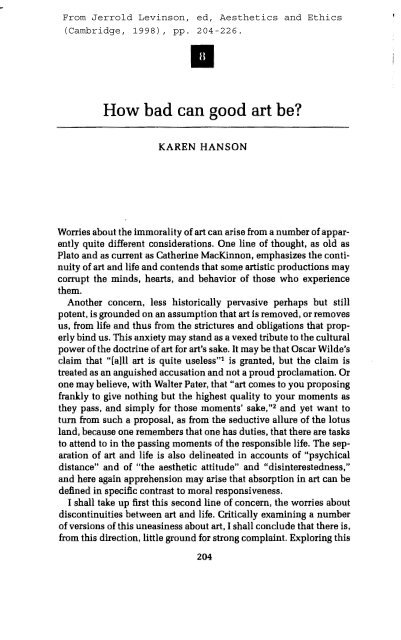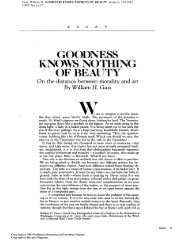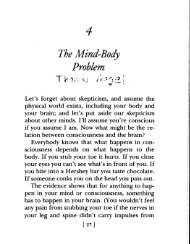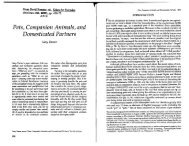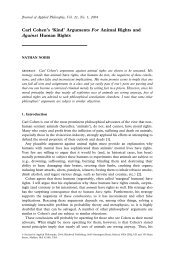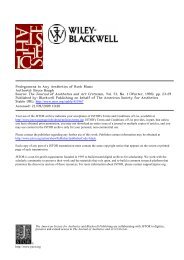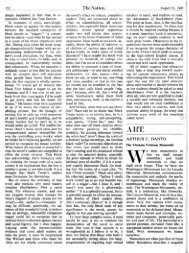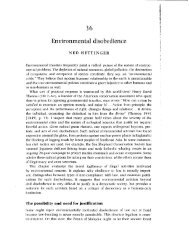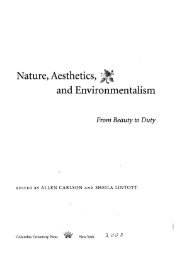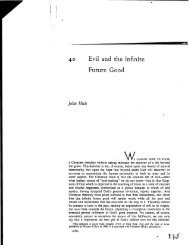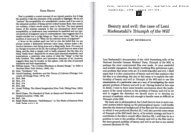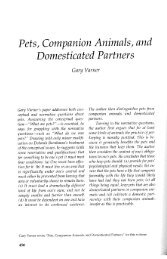Karen Hanson, "How Bad Can Good Art Be?"
Karen Hanson, "How Bad Can Good Art Be?"
Karen Hanson, "How Bad Can Good Art Be?"
- No tags were found...
Create successful ePaper yourself
Turn your PDF publications into a flip-book with our unique Google optimized e-Paper software.
•<br />
<strong>How</strong> bad can good art be<br />
KAREN HANSON<br />
Worries about the immorality of art can arise from a number of apparently<br />
quite different considerations. One line of thought, as old as<br />
Plato and as current as Catherine MacKinnon, emphasizes the continuity<br />
of art and life and contends that some artistic productions may<br />
corrupt the minds, hearts, and behavior of those who experience<br />
them.<br />
Another concern, less historically pervasive perhaps but still<br />
potent, is grounded on an assumption that art is removed, or removes<br />
us, from life and thus from the strictures and obligations that properly<br />
bind us. This anxiety may stand as a vexed tribute to the cultural<br />
power of the doctrine of art for art's sake. It may be that Oscar Wilde's<br />
claim that "[a]ll art is quite useless" 1 is granted, but the claim is<br />
treated as an anguished accusation and not a proud proclamation. Or<br />
one may believe, with Walter Pater, that "art comes to you proposing<br />
frankly to give nothing but the highest quality to your moments as<br />
they pass, and simply for those moments' sake," 2 and yet want to<br />
turn from such a proposal, as from the seductive allure of the lotus<br />
land, because one remembers that one has duties, that there are tasks<br />
to attend to in the passing moments of the responsible life. The separation<br />
of art and life is also delineated in accounts of "psychical<br />
distance" and of "the aesthetic attitude" and "disinterestedness,"<br />
and here again apprehension may arise that absorption in art can be<br />
defined in specific contrast to moral responsiveness.<br />
I shall take up first this second line of concern, the worries about<br />
discontinuities between art and life. Critically examining a number<br />
of versions of this uneasiness about art, I shall conclude that there is,<br />
from this direction, little ground for strong complaint. Exploring this<br />
204
<strong>How</strong> bad can good art be<br />
territory will lead, however, to a surprising point of contiguity with<br />
the first worry, the apprehension about the continuity between art<br />
and life. Returning, then, to the first, the historically recurrent complaint,<br />
and finding it both empirically and conceptually complex, I<br />
shall use it as a point of entry for a more general discussion of the role<br />
of ethical considerations in judgments of art. Defended in that discussion<br />
will be a particular idea of the invocation of moral considerations<br />
in aesthetic contexts, an idea that leaves some-but not unlimited<br />
- room for us to judge aesthetically excellent a work whose<br />
moral quality we firmly condemn.<br />
First, though, we must canvass the idea that art can be condemned<br />
because of its separation from the moral life. An interesting version<br />
of this concern is voiced by <strong>Art</strong>hur Dan to, who thinks<br />
there would be cases in which it would be wrong or inhuman to take an aesthetic<br />
attitude, to put at a psychical distance certain realities - to see a riot,<br />
for instance, in which police are clubbing demonstators, as a kind of ballet,<br />
or to see the bombs exploding like mystical chrysanthemums from the plane<br />
they have been dropped from. The question instead must arise as to what one<br />
should do. For parallel reasons, . . . there are things it would be almost<br />
immoral to represent in art, precisely because they are then put at a distance<br />
which is exactly wrong from a moral perspective. Tom Stoppard once said<br />
that if you see an injustice taking place outside your window, the least useful<br />
thing you can do is to write a play about it. I would go further, suggesting<br />
that there is something wrong in writing plays about that sort of injustice in<br />
which we have an obligation to intervene, since it puts the audience at just<br />
the sort of distance the concept of psychic distance means to describe: something<br />
like this has been offered as a criticism of the photographs of Diane<br />
Arbus. 3<br />
Danto's disquieting rumination suggests ethical perils on all sides:<br />
the art itself may be immoral, because it puts the audience at a distance;<br />
the artist may be judged morally wrong, for producing an<br />
object that has this effect; the audience may be judged wrong or inhuman,<br />
for taking an aesthetic attitude or remaining still, at a distance,<br />
when there is an obligation to intervene. <strong>How</strong> serious are these dangers<br />
<strong>Be</strong>fore we gauge the perils, before we afix blame or condemnation,<br />
we need to think more about the conditions of this assessment. The<br />
grounds for censure seem always roughly the same: some circumstances<br />
or events require action, and art in those circumstances or<br />
about those events not only does not count as, but in fact blocks,<br />
appropriate action. <strong>How</strong> does it do this The example of art that<br />
might have the Medusa-like power to turn those who look upon it to<br />
205
<strong>Karen</strong> <strong>Hanson</strong><br />
stone - namely, the photographs of Diane Arbus - seems to me not a<br />
help but a puzzle. Arbus's freakish or socially marginalized subjects<br />
do not, in any straightforward way, suggest injustice in need of our<br />
active intervention. If we had been there with Arbus as she shot photographs,<br />
had been there in the living presence of, say, a dwarf or a<br />
transvestite, what would morality have demanded that we do If<br />
there is no obvious answer to this, if no action is obviously required<br />
in the presence of her subjects, then how can Arbus's photographs be<br />
blamed for blocking the requirements of morality or sapping our will<br />
to act<br />
Perhaps, in this example, the moral objection is subtler. Is it that<br />
Arbus's photographs put us in a position to stare, to look without<br />
consequences at sights from which, in practical life, we might tum<br />
away in discomfort Perseus was able to see and slay the freakish<br />
Medusa because he avoided a direct, unmediated glance. He used<br />
Athena's shield to catch Medusa's reflection, and it was only the<br />
reflection that he kept in view. That might be a metaphor for the looking<br />
and seeing we can achieve through photographs, but it so far carries<br />
no hint of moral fault. I can imagine - I have seen- photographs<br />
that would elicit misgivings about the morality of looking, about personal<br />
privacy, exploitation, and unjustifiable intrusion. But if, with<br />
Arbus's work, we are made to stare frankly at those who, in life, we<br />
would ignore or spy upon with furtive glances, then it is not clear<br />
that our real-life responses have much positive moral weight. And<br />
we do not, after all, come close to killing or even wounding the dignity<br />
of Arbus's subjects. We do not, in looking at their photographs,<br />
override their wishes or participate in an evident abridgment of their<br />
sense of privacy.<br />
We might also remember, about the medium in general and not just<br />
about Arbus's use of it, that a photograph offers the viewer a sight of<br />
the past, so the idea of active intervention in the very particular<br />
event or circumstances photographed is, strictly speaking, vain. It<br />
may be, of course, that that is a nicety of airy metaphysics that weighs<br />
very little in grave matters of morality. A photograph shows you a<br />
Sudanese child starving, and you are moved to do something. By the<br />
time you reach Sudan to help, perhaps even by the time you write a<br />
check to a relief agency, perhaps even when you first see the photograph,<br />
that child may have already died; but the famine goes on and<br />
a practical response is surely not in vain. But, then, if photographs -<br />
and plays (think of A Doll's House) and novels (think of Bleak House<br />
or The Jungle) and so on- can in fact thus serve as spurs to action,<br />
206
<strong>How</strong> bad can good art be<br />
are we flatly rebutting the claims made by Danto and Stoppard, or<br />
obtusely missing their point<br />
If we focus on Dan to's assertion that "there is something wrong in<br />
writing plays about that sort of injustice in which we have an obligation<br />
to intervene," we may see traces of a Rousseauian objection to<br />
theater, to its capacity to pervert and dissipate true sentiment and its<br />
role in obscuring the genuine needs of our fellow human beings. 4 If<br />
the spectacle in the theater provokes us to tears, but then, refreshed<br />
and self-satisfied, we step outside and are blind to the sight of our<br />
freezing coachmen - or the freezing homeless - isn't there room for<br />
moral complaint It may not be clear, however, just where - against<br />
what or whom- the complaint should be lodged. If we do not see the<br />
connection between the pitiful events portrayed on stage and the<br />
dreadful circumstances on the street, why blame the play or playwright<br />
and not ourselves The idea is farfetched that a play might<br />
exhaust our capacity for sympathy and purge us of any inclination to<br />
behave responsibly in the face of real opportunities for doing so; but<br />
if there were such plays, isn't it we who should still be faulted for<br />
indulging in them, in preference to other works, as we might be<br />
faulted for choosing to dull our reactions to the misfortunes of others<br />
by indulging in drink or drugs It is, in any case, hard to see thatwhy<br />
or how - plays about injustice would necessarily have this<br />
deeply enervating effect.<br />
It may well be that it is simply psychical distance itself, or some<br />
instances of it, that Danto wants to condemn, and plays and playwrights<br />
are viewed with moral disapproval insofar as they present<br />
occasions for the realization of blameworthy distance. Moral suspicion<br />
of psychical distance could certainly be grounded on the fact<br />
that the latter notion is routinely defined by differentiating it from<br />
practical attitudes and moral concerns. Thus Bullough speaks of "the<br />
negative, inhibitory aspect" of distance, "the cutting-out of the practical<br />
sides of things and of our practical attitude to them, " 5 so that<br />
distance can supply "one ofthe special criteria of aesthetic values as<br />
distinct from practical (utilitarian), scientific, or social (ethical) values.<br />
" 6 And, of course, though Kant does not speak of "psychical distance,"<br />
he may be understood to lay the foundation for the notion<br />
with his account of the judgment of taste as "devoid of all interest"<br />
and his conceptual location of the beautiful in contradistinction to<br />
the agreeable and the good. 7<br />
Now the very idea of a disinterested aesthetic attitude has been<br />
subjected to a great deal of critical scrutiny, and many philosophers<br />
207
<strong>Karen</strong> <strong>Hanson</strong><br />
question the coherence of the traditional accounts of psychical distance.<br />
(Indeed, and somewhat puzzlingly, Danto himself notes that<br />
art "has often had useful roles to play as ... didactic, edificational,<br />
... or whatever, and the theory [of psychical distance and the aesthetic<br />
attitude) thus presupposes a degree of detachment available<br />
only in special periods of art history." "For this reason," he says, he<br />
"applaud[s] the polemic of George Dickie, who contests what he<br />
speaks of as 'the myth of psychic distance.' ") 8 If psychical distance<br />
is a mythological construction, Danto's moral worry may collapse. It<br />
is worth remarking, however, that even if some plausible notion of<br />
psychical distance can be preserved, it is not immediately clear that<br />
such distancing ever in itself constitutes a moral mistake. Something<br />
that might be described as distance - a space for thought and choice<br />
- seems fundamental to the realization of a developed moral life. A<br />
salient feature of the human condition is that our responses to the<br />
world are not always reflexive reactions to immediate impingements.<br />
(Compare, for sharp contrast, the life of the clam or the slug.) 9 Deliberate<br />
action - with options held out enough to be weighed - may not<br />
be all there is to the good human life, and objectivity- understood to<br />
involve a distinction between knower and known, between a thinker<br />
and an object of thought - may be an overrated or misunderstood<br />
epistemological ideal. Still, if "the question [is to) arise as to what<br />
one should do," it seems one must already be at some sort of distance<br />
from what "must" be addressed.<br />
Nonetheless, the examples used to suggest the moral questionableness<br />
of psychical distance seem somehow to carry argumentative<br />
force. Do they persuade by implying, perhaps illicitly and certainly<br />
without proof, that an aesthetic attitude or a distanced perception<br />
erases a prior, or precludes a subsequent or, say, alternating, practical<br />
or moral concern Would we condemn a psychologist studying<br />
the development of toddlers' problem-solving strategies because, at<br />
a moment when a subject child exhibits unhappy frustration, the<br />
psychologist maintains a cognitive attitude, seeking not to offer<br />
immediate comfort to the child but to record and make sense of the<br />
child's behavior If an individual shows nothing but a cognitive<br />
interest in others, we might, of course, be dismayed and disapproving,<br />
as appalled as we would be at one who sees a bloody riot only as<br />
a kind of ballet. But the scientific observer may also be a warm and<br />
responsive parent, may indeed, even at the same time as she is<br />
engaged in scientific observation, be emotionally attuned to register<br />
and react to the moment when a subject child's unhappiness should<br />
208
<strong>How</strong> bad can good art be<br />
be soothed and not merely noted. Similarly, one who attends to the<br />
perceptible form and sensuous surface of an event may also be capable<br />
of seeing the event's moral import and taking the implications for<br />
conduct. If by a definition of "psychical distance" aesthetic and<br />
moral attitudes cannot be simultaneous, why may they not be realized<br />
by an individual at what practically amounts to the same time<br />
If it is argued that split seconds can make a difference or, more<br />
plausibly, that something like the order or the predominant category<br />
of an individual's attitudes is signally important to our estimation of<br />
his or her moral character, this must be granted. After all, an adult<br />
whose first reaction to a crying child is always curiosity about what<br />
facts might now be revealed about the immature psyche, and who<br />
only subsequently remembers to offer some comfort, has a differentwe<br />
might say "colder"- character than one who comforts first and<br />
reflects later. And so, with Danto, we might judge "wrong or inhuman"<br />
a person whose first or typical reaction to violence is to aestheticize<br />
it, even if this individual manages also to behave appropriately<br />
in the face of violent events. But this does not show that putting<br />
certain realities at a psychical distance is inherently wrong or inhuman,<br />
any more than the example of the cold psychologist shows that<br />
trying to understand people is inherently at odds with caring for<br />
them. Dan to himself elsewhere recounts "Monet's anguished discovery<br />
that, sitting by the body of his late wife Camille, his model, love,<br />
support, angel, he had, instead of grieving, been studying the purple<br />
on her eyelids. He wondered what manner of monster he had<br />
become. " 10 Monet's horrified self-discovery, if it showed him to be a<br />
monster, showed him to be a monster of the sort Pascal calls<br />
"human." In the combination of his reaction and his reaction to his<br />
reaction, Monet must be seen as neither angel nor beast but a fragile<br />
thinking reed- loving, creative, and perceptive, a complex man.<br />
It might finally be said, now as a flat counterassertion, that Dan to's<br />
claim "that there is something wrong in writing plays about that sort<br />
of injustice in which we have an obligation to intervene" just seems<br />
decidedly implausible. If, as Danto admits, art can be didactic and<br />
edifying, why prohibit the theater from, or condemn it for, addressing<br />
large social issues and serious moral and political problems<br />
Stoppard's weaker line - "that if you see an injustice taking place<br />
outside your window, the least useful thing you can do is write a play<br />
about it"- is more tenable, but its reach as moral criticism is unclear.<br />
It echoes Wilde's "All art is quite useless," but while that is a defense<br />
against charges of immorality, Stoppard's comment is clearly depre-<br />
209
<strong>Karen</strong> <strong>Hanson</strong><br />
catory. Should it be taken as a summary of empirical evidence, a generalization<br />
about the marginality of theater's edifying powers or the<br />
fragility of art's connection to social action<br />
But if we are thus engaged in utilitarian calculations, then doesn't<br />
it matter keenly to know what kind of injustice is "taking place outside<br />
our window" Is someone being assaulted by a gang of muggers,<br />
or is a deadly epidemic being ignored by the medical establishment<br />
because most of its victims are politically powerless or socially<br />
"other" Don't we need to know, too, about our particular abilities<br />
and our other available options for action 1 If we see someone being<br />
mugged, then, depending on our strength and circumstances, it may<br />
be useful to intervene directly, and certainly we should call the<br />
police. (And might we not then also, when the immediate crisis is<br />
over, usefully incorporate something of this episode in our new<br />
play) 11<br />
But suppose we are concerned about the epidemic. Should we<br />
demonstrate in the streets, write letters to our political representatives<br />
and to the NIH, go back to school to learn to do medical<br />
research, establish or contribute to a new charity Both the nature<br />
and the extent of our obligations are, in this sort of case, much more<br />
difficult to discern. One of the obstacles to seeing the best course is<br />
that individual action, no matter how wisely chosen, is likely to be<br />
only slightly ameliorative, given the nature and the scale of the problem.<br />
This in fact is the case with most oftheproblems we might typically<br />
call "injustices" - economic inequities, violations of human<br />
rights, practices of racism, sexism, political domination, and so on.<br />
Now if these sorts of injustices cannot be solved by any individual's<br />
actions and may not be solved in any of our lifetimes, then, while we<br />
certainly have no excuse for doing nothing about these problems, we<br />
may have good reason not to belittle any serious attempts to address<br />
them. The cynic might note that the difference between "the least<br />
useful" and the most useful course of action is essentially negligible,<br />
given the enormity of these problems, and there is some truth to this.<br />
But the more optimistic assessment is that writing a play may be as<br />
good a way as any to take constructive action.<br />
Writing a play about the neglect of the AIDS epidemic may be as<br />
good a way as any other to address the problem - the problem of this<br />
injustice. We can leave aside for now, as only strengthening this<br />
defense of art, that the play may offer or sustain moral values - for<br />
example, compassion, individual comfort- other than those directly<br />
related to promoting social justice. Writing a play may be as useful a<br />
210
<strong>How</strong> bad can good art be<br />
mode of action as any other, provided, of course, that one has some<br />
writing talent aild some opportunity to have the play produced<br />
and seen, provided one isn't already employed as, say, an AIDS<br />
researcher, or the head of the NIH, or the president of the United<br />
States, or .... Remembering that both our native endowments and<br />
our acquired roles, our untapped personal talents and our undischarged<br />
social debts are among the conditions that determine the reasonableness<br />
or defensibility of a given course of action, we must<br />
assume that for each of us, at each stage of our lives, there will be better<br />
and worse bets about what course of action is likely to be most<br />
useful. If I am a middle-aged scientist with a good track record in<br />
medical research but no previous literary experience or calling, it is<br />
probably true that devoting myself to writing a play about AIDS is<br />
likely to be among the least productive things I might do (about<br />
AIDS). 12 We should thus at least qualify, relativize, the flat generality<br />
of Stoppard's claim. Remembering, though, that action is never<br />
accompanied by a guarantee of its felicitousness, we may also want<br />
to challenge more directly the assurance of Stoppard's assertion, but<br />
now with a worry about the uncertainties of moral luck.<br />
<strong>Be</strong>rnard Williams memorably sketches the problem of moral luck<br />
by drawing out the considerations relevant to the personal justification<br />
of an artist, an exemplary or schematized Gauguin. When Gauguin<br />
leaves his family destitute in order to pursue in Tahiti the development<br />
of his art, there can be nothing, at the time of his departure,<br />
that can justify his action: "Justification, if there is to be one, will be<br />
essentially retrospective. " 13 Success as an artist, the creation of world<br />
historically valuable art, is the only thing that can redeem his decision<br />
to depart, to abandon his domestic responsibilities, but success<br />
cannot be guaranteed - or even confidently predicted on reasonably<br />
adequate grounds - at the time of his departure. If the justification of<br />
important life projects - such as writing a play - sometimes depends<br />
on moral luck, on the projects' happening to turn out well, then we<br />
cannot say, as we commit ourselves to them, that these projects are<br />
definitely worthwhile or, more crucially, that they may rightfully take<br />
precedence over our standing obligations or over other tasks we might<br />
as reasonably undertake.<br />
Philosophers who accept the idea that morality and rational justification<br />
are subject to the vagaries of luck have various reactions to<br />
this disturbing thought. Either the nature or the scope of morality, or<br />
both, may seem deeply unsettled. Without proceeding further into<br />
this contested conceptual territory, we can simply note that if there<br />
211
<strong>Karen</strong> <strong>Hanson</strong><br />
is a problem of moral luck, it affects not just art and the artist, but<br />
every human enterprise. It is not just Gauguin, after all, bt~t also, say,<br />
the medical researcher, at the lab all day and into the night, who may,<br />
for example, neglect real family needs in order to pursue work. He or<br />
she might not need to discover a vaccine for AIDS in order to justify<br />
this one-track devotion, but something more than unimaginative<br />
dead ends and plodding bench work had better be discernible if a<br />
grim life judgment is to be escaped. If that is the bad news about<br />
moral luck, however, the good news is that the present decision to<br />
write a play cannot, at this moment, be definitively and conclusively<br />
condemned.<br />
Thus, Stoppard's particular judgment cannot be sustained. It may<br />
have been, in any case, only lightly offered. But another, more obdurate<br />
concern about the utility of art may still be pressed. If art is<br />
understood to be discontinuous with life, if it is thought that either<br />
the production or the enjoyment of art removes an individual from<br />
the practical and moral sphere of human existence, then, since the<br />
practical world is always brimming with injustice, indulgence in art<br />
must entail the gross neglect of some vital obligations. Given the<br />
apparent omnipresence of undeserved pain and dreadful suffering in<br />
the world we inhabit, there are always already some very basic<br />
claims upon our time and energy - so many, in fact, that we cannot<br />
possibly justify in terms of utility turning away from those problems<br />
and toward the development of art.<br />
The austerity of this moral outlook will, of course, dry up not only<br />
art, but also science and all liberal learning, and its account of our<br />
moral obligations will render all but the Mother Teresas among us<br />
exhausted failures. That some forms of utilitarianism seem to have<br />
these sorts of implications for moral assessment is now generally<br />
seen as a problem for those theories, not as a revelation that should<br />
come to guide our lives. It is worth remarking, however, that this<br />
complaint about art, grounded as it is on considerations of utility,<br />
often gains cultural currency through an edgy political alliance with<br />
an opposing view.<br />
If art can be condemned because, trafficking with it, we are moved<br />
to ignore the basic evil and suffering all around us, art can also, with<br />
adequate practical if not deep theoretical consistency, be condemned<br />
because, trafficking with at least some of it, we are corrupted, made<br />
more likely to contribute to the sum total of evil and suffering in the<br />
world. Blaming art for a purported discontinuity with life thus joins<br />
blaming art for purported continuities with mistaken lives, and the<br />
212
<strong>How</strong> bad can good art be<br />
moral space from which one might praise or even just leave art alone<br />
seems precipitously eroded. We have not, however, so far found<br />
much real reason to worry about a depraved discontinuity between<br />
art and life. Is the moral quicksand in fact on the other side, in the<br />
connection between art and life<br />
We should step carefully here, if only to mark off one serviceable<br />
path for exploration rather than another. To investigate the idea that<br />
art may corrupt, we need, of course, not only a standard of morality<br />
or, at any rate, some defensible moral judgments, but also some<br />
detailed empirical evidence. It may be no more difficult to gather and<br />
interpret properly evidence about art's effects than it is to obtain useful<br />
evidence about a host of other matters, but it is certainly not obvious<br />
that philosophy, or even what philosophy may call "common<br />
sense," has this evidence to hand.<br />
It must be admitted that current U.S.law has a different, a less cautious<br />
or more generous view of the disclosures here of common<br />
sense. Writing for the majority in Paris Adult Theatre I v. Slaton, and<br />
citing Justice Cardozo's assertion that "all laws in Western civilization<br />
are 'guided by a robust common sense,"' former Chief Justice<br />
Warren Burger dismisses the import of the argument that no scientific<br />
data conclusively demonstrate "that exposure to obscene materials<br />
adversely affects men and women or their society":<br />
If we accept the unprovable assumption that a complete education requires<br />
the reading of certain books, and the well nigh universal belief that good<br />
books, plays, and art lift the spirit, improve the mind, enrich the human personality<br />
and develop character, can we then say that a state legislature may<br />
not act on the corollary assumption that commerce in obscene books, or public<br />
exhibitions focused on obscene conduct, have a tendency to exert a corrupting<br />
and debasing impact leading to antisocial behavior 14<br />
Leaving aside the crucial issue of this·case, the controversy about<br />
state censorship, we can focus just on Burger's string of suggestions<br />
about the relations between art and morality and on his sense of the<br />
logical connections between those basic propositions. There seem to<br />
be no clear rules of deduction guiding an inference to the "corollary"<br />
that grounds the legislative action here in dispute, but, after all,<br />
Burger also acknowledges that all these contentions may simply be<br />
assumptions. Is there in fact widespread, common, acceptance of<br />
these claims Surely at least the first of these propositions - "that a<br />
complete education requires the reading of certain books"- is openly<br />
debated. That we do not have here a settled social assumption is<br />
213
<strong>Karen</strong> <strong>Hanson</strong><br />
shown by the intensity of current discussion about the content and<br />
aims ofliberal education and by the attacks on, and even the defenses<br />
of, the viability of "the canon." (Given the reality that school time, and<br />
indeed life, is limited, and apart from an admirable commitment to<br />
the idea that no education is ever truly complete, even the most conservative<br />
of the proponents of a traditional canon are likely to offer<br />
not a fixed list of "certain books," but at least some range, usually<br />
open-ended, of prized options.) Still, acceptance-or rejection- of the<br />
first assumption may be quite irrelevant to one's sense of the plausibility<br />
of the other propositions. Perhaps these other two ideas - that<br />
good books (plays, etc.) uplift and enhance the character ofthe reader<br />
and that bad books (plays, etc.) debase the reader's character- are<br />
widely held. They are certainly not real corollaries of one another, but<br />
Burger may be right that, in many minds, they are convictions somehow<br />
bound together. Is Burger also right that nearly everyone would<br />
immediately admit that good books develop good character<br />
Too many people are acutely aware of the emblematic, but historically<br />
real and genuinely problematic figure of the cultivated Nazi<br />
officer, so that univeral assent to this simple account of the relations<br />
between art and life will probably not be forthcoming. 15 Moreover,<br />
polling ourselves about the plausibility of these substantive, general<br />
claims -that good art has good effects and bad art corrupts -may not<br />
be the only, or the best, way of investigating something that, in these<br />
matters, is often called common sense. We might notice instead that,<br />
whether we hold or reject what Burger calls "the well nigh universal<br />
belief' about art's effects, we seem to have accepted the referential<br />
clarity of the phrase "good books, plays, and art." What do we have<br />
in mind here when we think of "good art"<br />
What particularly needs sorting out, in the context of these issues,<br />
is the extent to which - willfully or not, appropriately or not - we<br />
intertwine or even fuse moral and aesthetic judgment. Burger, for<br />
example, must not define "good art" as art that will "lift the spirit,<br />
improve the mind, enrich the human personality, and develop character,"<br />
or he would not feel obliged to give a hypothetical form to his<br />
consideration of what he takes to be common assumptions. Plato is<br />
sometimes thought to draw no distinction between aesthetic and ethical/political<br />
criticism of poetry, music, and drama, but his accounts<br />
of our common judgments of the poetry he would banish show that<br />
he recognizes, even as he hopes to counter, appraisals of art that are<br />
not drawn from ethical thought. (See, e.g., Republic 10, 605d [trans.<br />
Shorey]: "We praise as an excellent poet the one who most strongly<br />
214
<strong>How</strong> bad can good art be<br />
affects us," [the one who makes us] "feel pleasure, abandon ourselves<br />
and accompany the representation with sympathy and eagerness.")<br />
Tolstoy, too, is often understood as a moralist about aesthetic merit,<br />
and he does argue that art's value is ultimately determined by the<br />
religious perception of each era and society, with the best art now<br />
being Christian art, uniting humanity. Even Tolstoy, however, wants<br />
to make a clear distinction between judgments of "the quality of art<br />
as art" and a definition of "good and bad art with reference to its subject<br />
matter. " 16 It is only the latter that is grounded on the moral goal<br />
of human brotherhood. The quality of art as art is measured by its<br />
infectiousness - the individuality, clarity, and sincerity of the feelings<br />
it transmits - "apart from whether the feelings it transmits are<br />
good or bad. " 17<br />
On the other hand, Wilde- with his famous assertion that "[t]here·<br />
is no such thing as a moral or an immoral book. Books are well written<br />
or badly written. That is all"- presumably stands antipodean to<br />
Tolstoy, and yet Wilde too notes that "[t]he moral and immoral life of<br />
man forms part of the subject matter of the artist. " 18 If it is generally<br />
agreed that morality may be a part of the subject matter of art, part of<br />
its content, we must still consider disagreements concerning moral<br />
judgments about that content. Is moral criticism of art a thing apart<br />
from aesthetic criticism, with moral concerns trumping aesthetic<br />
ones, or not reaching their rarefied heights, or coequal but simply different<br />
Or should we expect a merging of moral and aesthetic values<br />
in our judgments about art Or does art possess immunity from ethical<br />
criticism, existing on an altogether different plane<br />
The idea that art is somehow beyond the reach of moral criticism<br />
may seem immediately implausible. Since art is, or is a product of,<br />
human activity, and since human action is among the natural subjects,<br />
is perhaps the central object, of moral evaluation, a theory that<br />
exempts art from moral evaluation may seem an untenable deus ex<br />
machina. Faith in this doctrine can be made more reasonable by taking<br />
care to limit its scope. It can be acknowledged that art, art making,<br />
and the experience of art may be considered from a variety of<br />
perspectives, placed in a variety of categories of activity or social<br />
practice. <strong>Art</strong> is, for example, economic activity. Material resources<br />
are used to make, exhibit, buy, and enjoy it, and the economic ramifications<br />
of a given piece or the conditions for a whole practice of art<br />
may be morally criticized. <strong>Art</strong> may be employed, say, to educate the<br />
young or to enhance a community's sense of cohesion, to break down<br />
or to build up common prejudices, and so on; and when we focus on<br />
215
<strong>Karen</strong> <strong>Hanson</strong><br />
these sorts of functions, on how well or how poorly they are performed,<br />
on whether they should be performed at all, our concerns<br />
may be primarily moral. When art is considered as art, however, and<br />
not in terms of any of its functions, why should it not be understood<br />
to ascend to a dimension that is its alone<br />
A parallel for this line of thought, a confirmatory model, may perhaps<br />
be drawn from a popular view of science. Scientific truths may<br />
be supposed unsusceptible ·.to ethical criticism, though it is readily<br />
admitted that their pursuit and application are appropriately evaluated<br />
from the moral point of view. Again, to sketch some parallel<br />
examples, the economic resources devoted to some scientific inquiry<br />
may be questioned, or we may praise or condemn the uses to which<br />
a discovery is put, but the discovery itself, the truth revealed through<br />
inquiry, cannot be placed on a moral grid.<br />
Philosophers have, of course, disputed the accuracy of this picture<br />
of value-free science, 19 but even if we set aside those fundamental<br />
controversies, we should notice two ways in which this comparison<br />
between art and science - far from enhancing the plausibility of the<br />
idea of art's immunity to moral judgment-tends instead to diminish<br />
the prospects for that idea. The first problem is that, in both science<br />
and art, the distinction between pursuit or practice, on the one hand,<br />
and finished achievement or accomplishment, on the other, is not<br />
always sharp or easily discerned. This may be only a minor problem,<br />
if a problem at all, for science, with its working commitment to epistemological<br />
fallibilism, its open and productive embrace of the possibility<br />
that today's best scientific theory may one day have to be<br />
scrapped or revised, may not yet be the final truth. An equivalent fallibilism<br />
in the realm of art would, however, vitiate utterly the aesthete's<br />
prohibition of moral criticism of artistic productions. For<br />
then, whenever this theorist declared a book, play, painting, or whatever<br />
off limits to moral evaluation, the question would inevitably<br />
arise, and with real force, "But is that book [play, painting, or whatever]<br />
art" If we cannot be sure that something is art, ifthe possibility<br />
always exists that what we are evaluating is instead only a wasteful<br />
attempt at art, or a shameless shamming of art, or retrograde<br />
political propaganda disguised as art, then we cannot be sure that<br />
moral evaluation is out of line.<br />
Waiting behind and related to this difficulty is the second problem<br />
with the scientific model's usefulness as an ally in art's attempt to<br />
exempt itself from moral evaluation._ When - or if- scientific truth is<br />
granted an exemption from morality's scope, it is because this truth<br />
216
<strong>How</strong> bad can good art be<br />
is conceived to be responsive only to brute reality, to be utterly independent<br />
of human desires, needs, and efforts. 20 Scientific truths may<br />
be uncovered because of human efforts, out of human needs and<br />
desires, but, on this picture, we pursue and discover, we cannot<br />
make, the truth. We do, of course, make art. It is wholly a product of<br />
our desires, needs, efforts, skill, intelligence, and so on. If there is<br />
such a thing as free will, then art, perhaps more than anything else,<br />
is made freely and willfully. Why should it not be a candidate for<br />
moral judgment<br />
If, after all, we are judged for making bombs or making peace, why<br />
can we not be judged for making a painting If we are judged for<br />
telling lies and for telling the truth, why can we not be judged for<br />
telling stories, writing novels If it is now granted that we, and our<br />
choice of activities, may be subject to moral scrutiny, but it is still<br />
insisted that art, the product of our activity, is beyond morality, the<br />
distinction seems desperate. It is, we must note, the nature of peace<br />
and the properties and consequences of bombs that help make our<br />
efforts to construct one or the other so appropriately subject to moral<br />
evaluation. Furthermore, the lies we tell, not just we in telling them,<br />
may be judged from the moral point of view: this lie, because of its<br />
superficial content and its function as a routine social gesture, is not<br />
so bad; that one, because of its cruelty and its significance, is despicable.<br />
In the end, though, as at first glance, it is the obvious fact that<br />
people make art, that art making is a human activity, that makes it<br />
inappropriate to try to isolate the realm of art from all prospect of<br />
moral evaluation. 2 1<br />
Accepting the idea that the content of art may be subject to moral<br />
evaluation, we may still disagree about the force and operation of<br />
such evaluation and, in particular, about its import for aesthetic judgment.<br />
There are at least two leading possibilities: art may be subject<br />
to moral assessment, but ethical judgments always remain distinct<br />
from aesthetic ones; or moral considerations are sometimes properly<br />
invoked in aesthetic criticism.<br />
Defending the first view, and arguing that the values of ethics and<br />
aesthetics (and all other "value areas") are "different and independent,"<br />
William Gass admits:<br />
In life, values do not sit in separate tents like harem wives; they mix and<br />
mingle .... A dinner party, for example, will affect the diners' waists, delight<br />
or dismay their palates, put a piece of change in the grocer's pocket, bring a<br />
gleam to the vintner's eye .... And if I, Rabbi <strong>Be</strong>n Ezra, find myself seated<br />
next to Hermann Goering, it may quite put me off the quail- quail which the<br />
217
<strong>Karen</strong> <strong>Hanson</strong><br />
Reichminister shot by machine gun from a plane. We should all be able to<br />
understand that. It would be a serious misunderstanding, however, if I imagined<br />
that the quail was badly cooked on account of who shot it, or to believe<br />
that the field marshal's presence had soured the wine, although it may have<br />
ruined the taste in my mouth. . . . [T]he meal will be well prepared or not<br />
quite independently of the guests' delightful or obnoxious presence, and it<br />
would be simple-minded to imagine that because these values were realized<br />
in such close proximity they therefore should be judged on other than their<br />
own terms- the terms, perhaps, of their pushier neighbors. 22<br />
Granting the idea that a dinner party can be analyzed from a variety<br />
of perspectives- in terms of the calories the guests consume, or in<br />
terms of the monetary cost of the food and wine, and so on- the crucial<br />
question remains, even with this deliberately impudent example:<br />
<strong>Can</strong> we neatly separate aesthetic from moral judgment If a dinner<br />
party were just the consumption of calories, Gass's claim might<br />
be easier to make. Then a "well-prepared" meal would just be one<br />
that makes those calories available for consumption, "quite independently<br />
of the ... delightful or obnoxious presence" of the others<br />
sharing the trough. But a good dinner party requires conviviality, and<br />
conviviality may be a product of the mix of food, drink, and guests.<br />
A "well-prepared" meal is not just a matter of culinary expertise<br />
directed toward an abstract, idealized gustatory receptor. <strong>Be</strong>efsteak<br />
in bearnaise sauce prepared by Jacques Pepin doing his best is still<br />
not a meal well prepared for baby's dinner on her first birthday.<br />
And what would Gass say if the field marshal brought to the cook<br />
not quail, but the body of a person he had shot Would the moral circumstances<br />
of cooking and consumption still be utterly independent<br />
of this meal's aesthetic merit Would this meal be well prepared if<br />
the thigh had been slow-roasted to an internal temperature of 165<br />
degrees, or should it be 180 And is it only U the meat thermometer<br />
registers 200 that I may justifiably complain that this joint is "badly<br />
cooked" Is it "simple-minded" of me to be unable to stomach, on<br />
any terms, the sight of this corpse on the table 23<br />
Gass seems to assume that one who intelligently commands value<br />
judgments can, in the end, sort values into separate tents and that<br />
intercourse with one "value area" is unaffected by the presence of the<br />
other tents. But just as the women of the harem affect one another,<br />
apart from the presence of or unbeknownst to the male, before he<br />
sends them to their separate tents, our values may be more intimately<br />
interrelated than we admit, and our analytical separation of value<br />
areas may simply disclose the partiality of our perspective, our igno-<br />
218
<strong>How</strong> bad can good ait be<br />
ranee of the ways in which our "distinct" value "types" affect and<br />
depend upon one another.<br />
In a memorable illustration of what he calls "a certain blindness in<br />
human beings," William James recounts his aesthetic horror when,<br />
journeying in the mountains of North Carolina, he saw valley after<br />
valley cleared of forest and scarred by primitive squatter farms. Upon<br />
hearing a mountaineer speak of these coves' "cultivation," however,<br />
James suddenly felt he had been missing "the whole inward significance<br />
of the situation." The clearings meant home, safety, and security<br />
for the mountaineers and their families: "[What] to me was a<br />
mere ugly picture on the retina ... was to them a symbol redolent<br />
with moral memories and sang a very paean of duty, struggle, and<br />
success. " 24 The values here realized evidently vary according to<br />
one's material relation to the clearings, but it is not merely that the<br />
mountaineer saw a positive economic value in the raw homestead,<br />
while James, from his comfortable academic position, had overlooked<br />
this aspect of the situation. It is rather that the very sight<br />
of the cove - the sight James initially saw as "ugly," "unmitigated<br />
squalor," oppressive "dreariness"- was seen by the mountaineer as<br />
suffused with spiritual warmth and the glow of fulfilled aspirations.<br />
Gass wants the aesthetic value of the sight to be judged "on its own<br />
terms," but it is the character of those terms, not just which term is<br />
"pushier," that is precisely what is often in dispute. Gass insists that<br />
the realization in close proximity of an array of values should not<br />
lead us to mistake one for another, but in fact the character of a term<br />
of evaluation -like our own character- may be deeply influenced by<br />
the neighborhood in which it was developed.<br />
Gass contends that "[a]rtistic quality depends upon a work's internal,<br />
formal, organic character, upon its inner system of relations,<br />
upon its structure and its style, and not upon the morality it is presumed<br />
to recommend." 25 Among the problems with this blunt and<br />
sweeping declaration, however, is that it is not obvious that a work's<br />
"organic character" is inherently amoral or that the most salient<br />
inner system of relations will never have a moral cast. Nor is it clear<br />
that considerations of the morality of a work must take the form of a<br />
presumption about the work's "recommendations." Arnold Isenberg<br />
reminds us that even didactic literature -which, he says, either "features<br />
regular ethical terms, such as 'good', 'evil', 'right', 'wrong'," or<br />
is "cast in the imperative mood," or "assembles descriptive propositions<br />
in such a way as clearly to point to a moral conclusion" 26 -<br />
while it may seem the strongest case "of moral involvement among<br />
219
<strong>Karen</strong> <strong>Hanson</strong><br />
the fine arts, " 27 need not necessarily be understood as making recommendations.<br />
The content of, for example, a poem, what it says,<br />
may be moral (or moralistic), but whether the poem must- or even<br />
should -be taken to be hortatory is another matter.<br />
It is not just that some apparently didactic stanzas may be, for<br />
example, part of a parody or satire, or that they may be dialogue in a<br />
play and thus the dramatic utterance, the expression, of a particular<br />
character in the drama, or that the lines may be quoted in another<br />
poem, only to be poetically disputed. The more fundamental point is<br />
that the moral content of a work of art does not always serve as a<br />
moral precept. If one does not see this, according to Isenberg,<br />
it is because one does not understand what other roles may be played by<br />
moral ideas: one does not, for instance - though understanding very well<br />
how the side of a mountain can be an object of interest for one who is neither<br />
a geologist nor a surveyor- see how a "side" of a moral question can be<br />
an attractive thing, in itself and apart from its merits as a solution to that<br />
question. 28<br />
This way of putting what can serve as a rejoinder to Gass serves also,<br />
however, to lay the groundwork for Isenberg's own argument that<br />
didactic content can be put to a purely aesthetic use. The aesthetic<br />
assimilation of moral content occurs, according to Isenberg, when the<br />
moral understanding is called "into a kind of free play"; we "give ourselves<br />
over to the reception of moral ideas," "occupying a middle<br />
position between sensory enjoyment and moral deliberation. " 29 But<br />
Isenberg's confidence that there is a middle position here may depend<br />
upon his situating deliberation too far toward the side of practical<br />
action - and indeed he suggests that, in aesthetic criticism, we stop<br />
"trying to evaluate moral ideas depth wise -that is, in terms of their<br />
connections with action and eventual result. " 30 But in fact moral<br />
deliberation may often stop well short of fixing a course of conduct,<br />
and it can be called out by considerably less than a currently pressing<br />
practical problem. It is true that deliberation will weigh what might<br />
be called the "merits" of a given "side" of a moral question. But then<br />
how could something called "moral understanding," even if engaged<br />
in "free play," find a moral side "attractive" apart from its merits<br />
When Lionel Trilling argues for the aesthetic relevance- not assimilation<br />
or reductive resolution - of ideas, and intellectual cogency, in<br />
literature, he notes that<br />
we can take pleasure in literature where we do not agree, responding to<br />
the power or grace of a mind without admitting the rightness of its inten- ,<br />
220
<strong>How</strong> bad can good art be<br />
tion or conclusion - we can take pleasure from an intellect's cogency, without<br />
making a final judgment on the correctness or adaptabilty of what it<br />
says. 31<br />
There seems no reason why ideas, in literature or in any other art that<br />
might supply them, may not be moral as well as nonmoral, but to<br />
respond to their cogency we must see their cogency, understand how<br />
they fit together (their "inner system of relations," according to Gass),<br />
and the relative force of the case this work makes for them. If we then<br />
can take pleasure in, or judge aesthetically excellent, a work whose<br />
moral quality we might judge evil, we may indeed be responding to<br />
"the power and grace" exhibited on behalf of that "side" of the moral<br />
question. It would be a mistake, however, to think of this response as<br />
"purely aesthetic." Power and grace are intellectual and moral virtues,<br />
as much as they are aesthetic qualities, and it may require clear<br />
thought and some moral deliberation to grasp their presence.<br />
It is perhaps worth mentioning, in this context, that when Hume<br />
sets out his famous attack on immoral art - his denunciation of the<br />
"deformity" of vicious art, and his claim that to "confound the sentiments<br />
of morality and alter the natural boundaries of vice and virtue"<br />
is, in art, "an eternal blemish"- the factors he specifically mentions<br />
as art's deforming malefactors are "bigotry and superstition. " 3 2 Hume<br />
may not have been careful enough, in his appraisal of art, to recognize<br />
that "vicious manners" could be "described without being<br />
marked with the proper characters of blame and disapprobation" 33<br />
and yet still not be recommended. And he should have seen that<br />
even if an artwork were to recommend viciousness, the boundaries<br />
of vice and virtue would not then necessarily be conflated.<br />
Nonetheless, in identifying bigotry and superstition as the spoilers<br />
of art, he effects a point of contact with those of us who are attracted<br />
to the case for the moral evaluation of art, but who grant the excellence<br />
of some art whose morality we deplore. For bigotry and superstition,<br />
as Hume understands them, are exactly the opposite of<br />
cogent thought and genuine deliberation. Thus, art marked by bigotry<br />
and superstition is art deprived, to that extent, of power and<br />
grace. This is not to deny that bigotry and superstition can be powerfully<br />
conveyed and inculcated by means of art. It is to insist that<br />
bigotry in art, patently weak thought, and intellectual confusion<br />
count as artistic, as aesthetic, flaws. The work is, as art, worse for<br />
their presence, and we should find unredeemed displeasure in the<br />
surfacing of these defects.<br />
If it is objected that this suggestion aestheticizes morality, and we<br />
221
<strong>Karen</strong> <strong>Hanson</strong><br />
are brought curiously full circle to earlier worries about aesthetic distance<br />
and inaction, then we must note, first, that moral ideas, whatever<br />
their source, are felt as well as thought and, second, that the<br />
moral content of art, if such there be, is subject to deliberation as well<br />
as delectation. In our lives - and in and through the art that is a part<br />
of our lives-we can remain alive to the force of ideals we do not now<br />
share and to the pull of alternative evaluative schemes. We in fact<br />
cannot, in our conduct, honor all the moral ideals that may, in abstract<br />
thought and even in the lives of others, seem worthy, admirable, or in<br />
some way attractive. This is not because - or not alone because - of<br />
pervasive weakness of the will. The more fundamental problem is the<br />
practical incompatibility of, the friction between, a wide variety of<br />
recognized, or tempting, ideals. One may try to combine a commitment<br />
to, say, humility and nobility, but the sharp edges of each virtue<br />
are likely to be substantially smoothed if they are subject to a common<br />
incarnation. Or one may, out of deliberation or temperament, utterly<br />
reject some durable calls to moral responsiveness. One may, for example,<br />
conclude, and for good reason, that duty structures the moral life<br />
and that unprincipled compassion is a mistake. An artwork that<br />
makes a plea for the value of compassion may then seem troublesome.<br />
Alternatively one may, upon equally defensible reflection, see sympathy<br />
and fellow-feeling, not rules and laws, as the core from which<br />
the highest morality is built. An artwork that is a brief for duty and<br />
nobility may then seem worrisome.<br />
But, as Emerson claims, "In every work of genius we recognize our<br />
own rejected thoughts: they come back to us with a certain alienated<br />
majesty. Great works of art have no more affecting lesson for us than<br />
this. " 34 <strong>Art</strong>'s capacity to keep alive certain moral perspectives, even<br />
if these views diverge radically from our present moral outlook, can<br />
help us remain alert to life's possibilities and our own potentialities.<br />
This is a benefit that is neither merely aesthetic, nor solely moral; it<br />
is both at once.<br />
Notes<br />
1. Oscar Wilde, Preface to The Picture of Dorian Gray. in The Portable<br />
Oscar Wilde, ed. R. Aldington (New York: Viking Press, 1946), 139.<br />
2. Walter Pater, The Renaissance (New York: Modem Ubrary, 1873), 199.<br />
3. <strong>Art</strong>hur Danto, The Transfiguration of the Commonplace (Cambridge,<br />
Mass.: Harvard University Press, 1981), 22.<br />
222
<strong>How</strong> bad can good art be<br />
4. It would be exegetically crude to attribute this objection, in just this<br />
form, to Rousseau himself. But Rousseau certainly worries about the corrupting<br />
possibilities of theater and about tragedy's capacity to excite "a<br />
barren compassion indulging itself in a few tears, but never productive<br />
of any act of humanity" (An Epistle from f. f. Rousseau to Mr. D'Alembert,<br />
in Miscellaneous Works of f. f. Rousseau, vol. 3 [New York: Burt<br />
Franklin, 1972], 34).<br />
5. Edward Bullough, "'Psychical Distance' as a Factor in <strong>Art</strong> and as an Aesthetic<br />
Principle," British Journal of Psychology 5 (1912): 89.<br />
6. Ibid., 118.<br />
7. Immanuel Kant, Critique of Pure Judgment, trans. J. H. <strong>Be</strong>rnard, First<br />
Part, First Book, First Moment (New York: Hafner, 1968), 37-45.<br />
8. Danto, Transfiguration, 23.<br />
9. See the American pragmatists, especially G. H. Mead and John Dewey, on<br />
this point. Mead, in Mind, Self, and Society and The Philosophy of the<br />
Act, argues that conscious control and intelligent behavior depend upon<br />
a capacity for delayed reactions; and he and Dewey- the latter in, e.g.,<br />
Human Nature and Conduct and Experience and Nature - characterize<br />
deliberation, including moral deliberation, as imaginative rehearsal, the<br />
playing out in thought of habits and tendencies to act that are temporarily<br />
blocked from external manifestations in conduct.<br />
Consider as well Emerson and Nietzsche on distance. Their different<br />
but related treatments of this idea are differently ambivalent and equivocal.<br />
Emerson and Nietzsche seem to agree, however, on the epistemological<br />
importance of the idea, and they suggest that a kind of distance<br />
is not merely a valuable human achievement but also a necessity for the<br />
realization of art. (For a comparison of Nietzsche and Emerson on the<br />
notion of distance, see K. <strong>Hanson</strong>, "Approaching Distance," International<br />
Studies in Philosophy 24, no. 2 [1992]: 33-40.)<br />
This notion that ideas of distance have surfaced in accounts of practical<br />
reason and successful epistemology - consider also the power<br />
imputed to "theoretical distance" - is not an assertion that, in these various<br />
occurrences, the meaning of "distance" is always the same. Indeed,<br />
part of what is in question here is the meaning, the import, of the idea of<br />
aesthetic or psychical distance. But if the latter is characterized essentially<br />
in negative terms, as the inhibition of the practical, then it certainly<br />
baffles an immediate moral condemnation of psychical distance<br />
that coherent accounts of moral deliberation seem to secure a space for<br />
this inhibition.<br />
10. Danto, Transfiguration, 143.<br />
11. I do not wish, with this question's utilitarian spin, to deflect attention<br />
from a different, and I think deeper, moral problem that hovers at the<br />
edge of this discussion. What constraints, if any, govern the use, in art,<br />
of events and experiences drawn directly from life Morally salient<br />
questions about sincerity, authenticity, fidelity, and personal loyalty<br />
may well arise when there is narrative incorporation, within an artwork,<br />
223
<strong>Karen</strong> <strong>Hanson</strong><br />
of one's own or others' particular experiences. Issues of privacy are also<br />
pertinent, and it must be remembered that even autobiography involves<br />
the appropriation, the use, of (at least one version of some portion of the<br />
lives of) others- friends, enemies, relatives, strangers.<br />
12. For this schematic example to have force, the stipulations must of course<br />
be taken seriously, as must its probabilistic formulation; otherwise, one<br />
may well think of Dr. Chekov.<br />
13. <strong>Be</strong>rnard Williams, Moral Luck (Cambridge University Press, 1981), 24.<br />
14. U.S. Supreme Court 413 U.S. 49 (1973).<br />
15. Jerrold Levinson offers an interesting discussion of this sort of case, the<br />
cultivated Nazi, in "Evaluating Music," Revue Internationale de Philosophie<br />
198 (1996): 593-614. He suggests that such cases are so striking precisely<br />
because they are exceptional, because they "violate an empirically<br />
based norm of artistic taste comporting with some degree of moral<br />
awareness." My own view is that it is the extremity of the case that is<br />
exceptional. It is the literal monstrousness of artistic sensitivity coupled<br />
with participation in genocide that strikes us. We would not be at all surprised,<br />
I think, by the case of a person with exquisite taste in music,<br />
someone who exhibits a sensitive ear and discerning appreciation, who<br />
nonetheless is, say, callous and self-centered, insensitive to friends and<br />
associates.<br />
16. Leo Tolstoy, What Is <strong>Art</strong> trans. A. Maude (Indianapolis: Library of Liberal<br />
<strong>Art</strong>s, 1960), 142.<br />
17.' Ibid.<br />
18. Wilde, Preface to Dorian Gray, 138.<br />
19. The issue goes back at least as far as William James, who argues for a conceptual<br />
connection between truth and human interests and values. More<br />
contemporary attention to a range of related questions about the content<br />
of science can be seen in, e.g., Thomas Kuhn's The Structure of Scientific<br />
Revolutions (Chicago: University of Chicago Press, 1962), 2d ed. 1970;<br />
Israel Scheffler's Science and Subjectivity (Indianapolis: Bobbs-Merrill,<br />
1967) and "Vision and Revolution: A Postscript on Kuhn," Philosophy of<br />
Science 39 (1972): 366-74, reprinted in Scheffler's Inquiries (Indianapolis:<br />
Hackett, 1986); Evelyn Fox Keller's "Feminism and Science," in Sex<br />
and Scientific Inquiry, ed. S. Harding and J. O'Bar (Chicago: University of<br />
Chicago Press), 233-46; E. McMullin (ed.), The Social Dimensions of Science<br />
(Notre Dame, Ind.: University of Notre Dame Press, 1992); and many<br />
of the essays in The Philosophy of Science, ed. R. Boyd, P. Gasper, and<br />
J.D. Thout (Cambridge, Mass.: MIT Press, 1991).<br />
20. It should be underscored that this point is intimately related to the one<br />
in the preceding paragraph. The embrace of fallibilism can work in science<br />
to reinforce the idea of objectivity because, if it is nonsubjective<br />
reality that ultimately controls or coerces scientific results, then the<br />
terms in which one might criticize proffered achievements- claims that<br />
proffered claims do not accord with reality- are relatively clear, clearly<br />
agreed upon, and clearly not moral. But comparable constraints on prof-<br />
224
L<br />
<strong>How</strong> bad can good art be<br />
fered art are not clearly available. Thus, it will not do to pretend to<br />
embrace a comparable fallibilism in the realm of art, suggesting that we<br />
cannot be sure, for any candidate art, whether it really is art, but insisting,<br />
still, that true or genuine art may yet be immune from moral criticism.<br />
It is precisely because there is no practical agreement on the ultimate<br />
constraints of art that an ad version here to the idea of the "true" or<br />
the "genuine" is quite empty- radically undeveloped conceptually and,<br />
partly because of that, of no use in furthering a possible parallel between<br />
moral immunity in science and in art. (John Brown's useful commentary,<br />
at the University of Maryland conference for which this essay was originally<br />
prepared, prompted this elaboration.)<br />
21. Indeed, the linkage between something's being the product of human<br />
activity and something's being an appropriate subject for moral concern<br />
is so tight that it may supply an inappropriate bit of support for Dan to's<br />
thoughts about psychical distance. It is perhaps no accident that Bullough's<br />
original illustration of the phenomenon of psychical distance,<br />
the example he uses to establish the meaning of the term, is the sea fog<br />
abstracted in experience from "its danger and practical unpleasantness."<br />
The natural world, apart from human beings, is not a natural locus for<br />
moral concern and assessment, so when Bullough asks us to imagine<br />
putting aside practical considerations about the sea fog in order to<br />
achieve the thrill of psychical distance, morality does not impede our<br />
compliance by standing before us with stem practical demands. A move<br />
to relish the sensuous surface of the situation may proceed without serious<br />
obstacles. Danto's politically charged riot (with "police clubbing<br />
demonstrators") and bombs dropping from airplanes are, however, situations<br />
already fraught with moral agency and essentially defined by<br />
sociopolitical responsibilities. Abstracting in these situations from considerations<br />
of morality may indeed, then, be "wrong or inhuman," but<br />
not (just) because we have an obligation to intervene; the problem is<br />
rather that the human responsibility for these situations, the human<br />
agency that stands behind them, demands, appropriately calls out for,<br />
moral assessment. This is not to say that the issues at stake could not be<br />
recast in a less prejudicial form. We could consider whether it would be<br />
wrong or inhuman to put at a psychical distance a natural catastrophe<br />
now threatening or claiming human lives: an earthquake is beginning to<br />
rumble through our town, or the sea fog leads to the collision of two<br />
ships ...<br />
22. William Gass, "<strong>Good</strong>ness Knows Nothing of <strong>Be</strong>auty: On the Distance<br />
between Morality and <strong>Art</strong>," in Reflecting on <strong>Art</strong>, ed. John Fisher (Mountain<br />
View, Calif.: Mayfield, 1993), 110, 112.<br />
23. In his conference commentary on this essay, John Brown suggested that<br />
this response to Gass turns on a conflation of the "well-planned party"<br />
and the "well-prepared dish." Brown noted that dishes are typically<br />
judged not by moral criteria but by culinary ones, the standards of a cuisine<br />
being assumed to be morally acceptable.<br />
225
<strong>Karen</strong> <strong>Hanson</strong><br />
That is probably a correct account of our typical practice, but it begs<br />
the question I take the extremity of the example to highlight. We do not<br />
"assume" the acceptability of a cannibalistic cuisine, and if we were in<br />
the untypical position of being served cooked human flesh, then moral,<br />
not culinary, criteria would surely come to the fore. The more general<br />
lesson of the extreme example is that our assumptions about moral<br />
acceptability, or irrelevance, may sometimes be unsettled and our typical<br />
practices of judgment open to confoundment. Gass suggests that it is<br />
simple-minded not to judge things on "their own terms." But the very<br />
question at issue may be "What are the relevant terms of judgment"<br />
A focus on the cooked quail can lull us into the belief that we can<br />
always sustain a distinction between value areas, always make a distinction<br />
between a bad thing done and a thing badly done. For many of<br />
us, though of course not for all, the cooking of quail does not seem a bad<br />
thing, and the dish is simply well or badly prepared. But the idea of a<br />
thing "badly done" depends for its sense upon assumed standards, tacit<br />
expectations, a relatively clear notion of what the "thing" is that has<br />
been botched. The creAtive and innovative character of art, however,<br />
suggests there may be trouble, in this sphere, with the idea of assumed<br />
standards and tacit expectations.<br />
24. William James, "On a Certain Blindness in Human <strong>Be</strong>ings," in Talks to<br />
Teachers (New York: Norton, 1958), 152.<br />
25. Gass, "<strong>Good</strong>ness," 115.<br />
26. Arnold Isenberg, Aesthetics and the Theory of Criticism (Chicago: University<br />
of Chicago Press, 1973), 270.<br />
27. Ibid., 269.<br />
28. Ibid., 272.<br />
29. Ibid., 274.<br />
30. Ibid., 280.<br />
31. Lionel Thilling, The Liberal Imagination (New York: Viking Press, 1950),<br />
291.<br />
32. David Hume, The Standard of Taste, in Essays and Treatises on Several<br />
Subjects (London: 1758), 146.<br />
33. Ibid., 145.<br />
34. Ralph Waldo Emerson, "Self-Reliance," in The Works of Emerson (New<br />
York: Tudor, n.d.), 1: 31.<br />
226


